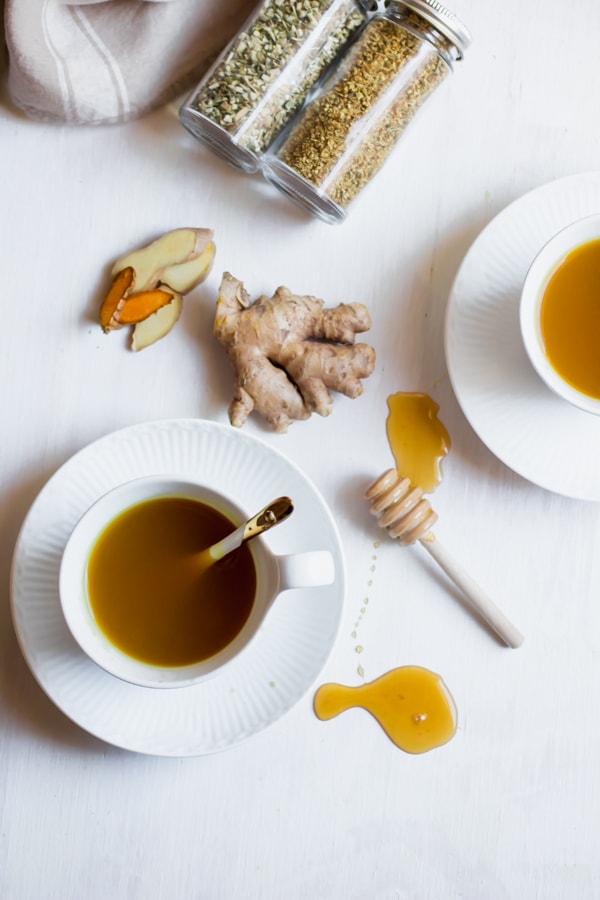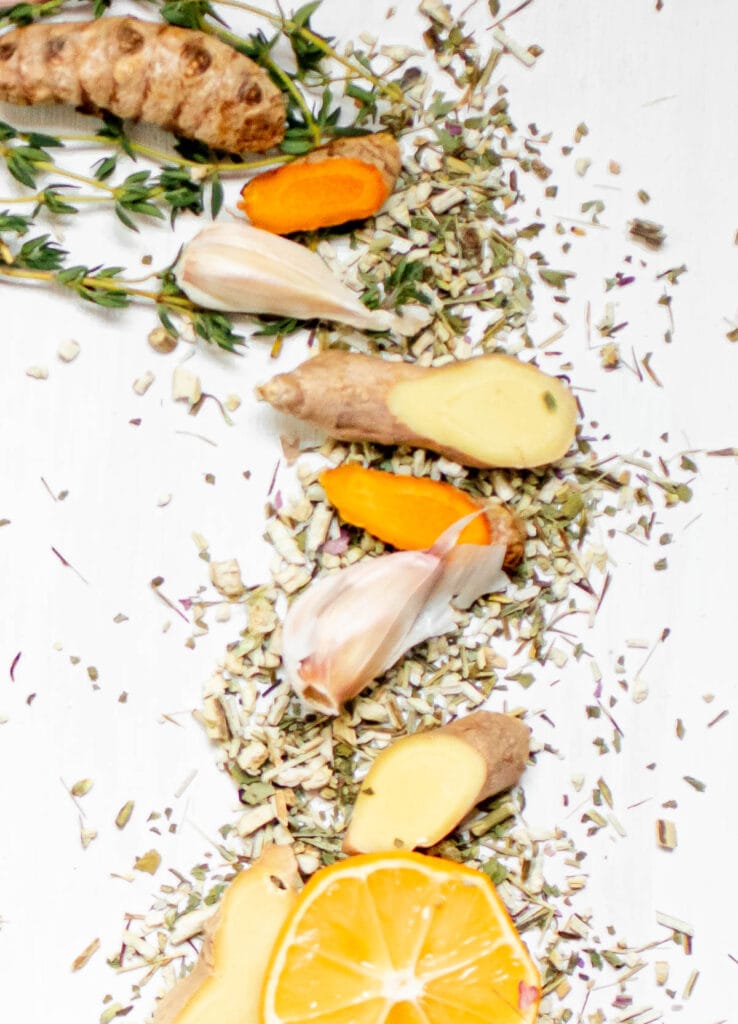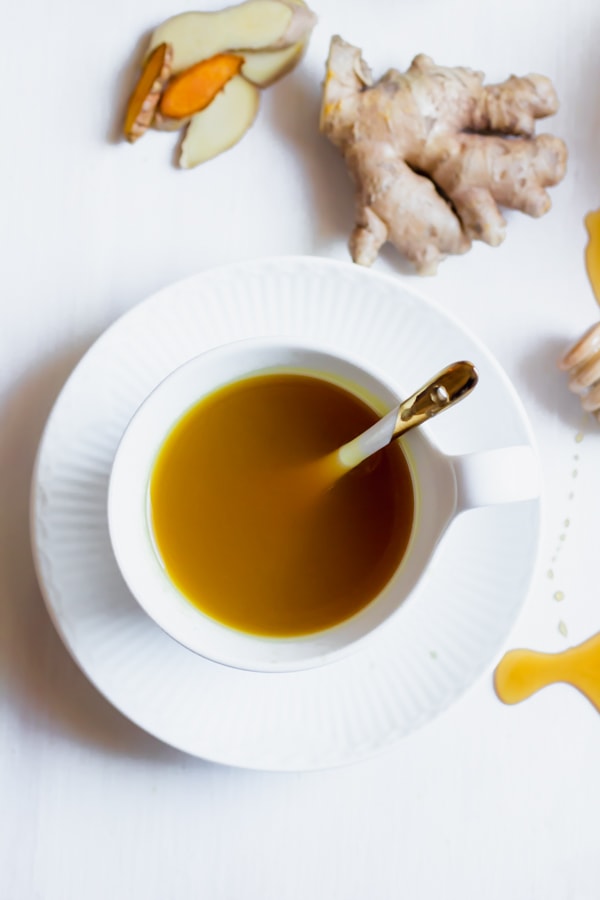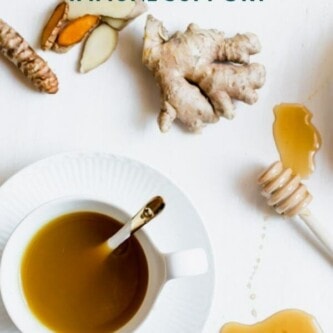Homemade echinacea tea is the perfect soothing beverage for your immune system on cold winter days. This version combines the medicinal benefits of other herbal superstars like elderflower and ginger root for a blend that's more potent I call this flu-fighting tea, for good reason!

If you are looking for more homemade herbal remedies, be sure to visit my comprehensive post on Natural Cold and Flu Remedies. I also do a deeper dive into Elderberry when I show how to make this amazing Elderberry Syrup. Aside from its healing power it also tastes great in my Apple Cider Immunity Sparkler Cocktail.
This is one of my favorite herbal teas, not just for its healing powers but because I also love the way it tastes. It's simple enough to make with just a few excellent ingredients, is packed with health benefits, and tastes way better than store-bought tea bags. This is going to be a lifesaver for you this flu season. As the seasons change and our immunity is challenged it's the perfect time for a hot cup of echinacea tea.
You'll Love this Recipe
- A basic recipe that is anything but basic. This blend is like an all-star list of potent plants that are often used as herbal medicines.
- This herbal blend is an all-purpose remedy to be taken at first sign of sickness to help ward off your runny nose and watery eyes. This immune support powerhouse is packed with anti-inflammatory properties. I like to enjoy my tea with a spoonful of raw honey as soon as I feel the first signs of a cold or the sniffles.
Let's Get Brewing!

Echinacea Tea Basics
The echinacea plant, also known as the purple coneflower, is a perennial plant that is native to eastern and central America. Echinacea tea is made using the whole plant, leaves, stem, roots, and flowers.
Echinacea has a sweet grassy flavor (I love it) and is used as a potent therapeutic due to its anti-inflammatory, anti-viral, and antibacterial properties.
Studies have shown that echinacea reduces the severity of cold and flu and decreases the time you have it. This comprehensive meta-analysis concluded that in sixteen trials (eight prevention trials, and eight trials on treatment of upper respiratory tract infections) with a total of 3396 participants, that some Echinacea preparations may be better than placebo.
Echinacea acts like a powerful shield blocking harmful bacteria from gaining access to healthy cells. Unlike antibiotics which directly attack bacteria, echinacea makes our own immune cells more efficient. Evidence indicates that echinacea potently lowers the risk of recurrent respiratory infections and complications thereof. Immune modulatory, antiviral, and anti-inflammatory effects might contribute to the observed clinical benefits, which appear strongest in susceptible individuals.

Why is this Tea Supercharged?
Echinacea tea is clearly potent, but I love combining echinacea with other immune supportive herbs like elderflower, ginger, cinnamon, and clove. This tea is the ultimate cold combating flu fighting blend.
Ingredient Highlights – Why These Herbs are Potent Immune Support Tools
This tea has some serious fighting power thanks to the following potent cold and flu heavyweights:
- Echinacea – Studies have discovered that echinacea harbors a variety of active compounds acting as antioxidants, such as alkamids, phenolic acids, polyacetylenes, glycoproteins, and polysaccharides. Additionally, it features caffeic acid, known for its antimicrobial attributes. Ingesting echinacea, whether as a tea or in other forms, may support immune response, regulate blood sugar levels, and promote a sense of calm. Furthermore, its anti-inflammatory, antibacterial, and antiviral properties have rendered it a sought-after ingredient in skincare products aimed at addressing acne and promoting healthy aging. RESEARCH CITATION
- Elderflower – Elderflower has been used medicinally for centuries to aid in swollen sinuses (sinusitis), colds, influenza (flu), swine flu, bronchitis, diabetes, and constipation. This study which studied elderflower as a potential functional food in the management of diabetes found that most of the phenolic constituents and several of the metabolites showed high antioxidant activity. This antioxidant activity is purportedly what makes elderflower an excellent tool for our cold and flu arsenal.
- This study which analyzed the antioxidant power (FRAP) assays revealed that the teas prepared from flowers had higher mean 2,2-diphenyl-1-picrylhydrazyl (DPPH) and FRAP activities than the teas prepared from berries. Therefore, elder beverages could be important dietary sources of natural antioxidants that contribute to the prevention of diseases caused by oxidative stress.
- Turmeric – Potent anti-inflammatory effect (read all about it here)
- Ginger – Antimicrobial and anti-inflammatory. In addition to treating cold and flu, ginger is excellent for nausea and vomiting. Ginger is also known to contain medicinal compounds effective at halting bacterial infections. Ginger has also exhibited therapeutic antibacterial activity against respiratory pathogens (study).
- Cinnamon – Has exhibited antiviral activity against various influenza viruses and has been shown to reduce inflammation.
- Clove – Has been used traditionally to ease the pain of toothaches due to its anesthetic properties. Clove can also be used to soothe a sore throat.
- Cayenne – Increases circulation and supports bringing heat to the body, which can help dispel coldness.
- Lemon – High in vitamin C.
- Buckwheat Honey – Increases serum antioxidant capacity (study). One study investigated the use of buckwheat honey as a treatment for nighttime coughs in children due to respiratory infections, like colds. The study found that buckwheat honey was more effective than over-the-counter cough medicine.
How to make Homemade Echinacea Tea (Supercharged)

- Combine all ingredients in a large teapot. Pour boiling water over the ingredients and allow to steep for 5-10 minutes. If you have a tea infuser this will help contain all the plant parts and ingredients.
- Pour the tea into individual mugs and add a squeeze of fresh lemon and raw honey to taste.
Expert Tips
- You can adjust this recipe to include items you have on hand, but I do recommend starting with a base of echinacea.
- I tend to like more cinnamon and clove and oftentimes will just freehand pour those ingredients in.
- Some people make tea with the fresh purple flowers of the colorful echinacea plant. This is a lovely method however you will need twice the amount of fresh leaves to get the same level of strength and echinacea tea taste from the dried root. Fresh echinacea flowers are also more difficult to come by in the winter months if you live in a climate that gets cold. Whichever you choose, both will produce a great cup of echinacea tea.
Storage and Reheating Instructions
- STORAGE – If anyone in my house is under the weather I make a large batch of this tea and store it in a large mason jar in the fridge.
- REHEATING – Reheat in a small pot on the stove.
FAQ
Avoid cola, coffee, and energy drinks as the combined effects of these caffeinated drinks can increase caffeine side effects such as headaches.
Echinacea has a strong flavor with floral notes. ‘It has the sharp freshness of pine needles and the soft, round flavor of meadowsweet'.
Echinacea tea is made from all parts of the plant, root, stem, and leaves. If you use fresh flowers avoid using the seed heads as they are bitter and will alter the taste of the tea.
There are no formal dosage recommendations for echinacea tea but based on clinical experience I recommend drinking echinacea tea at the first sign of illness and continuing for no more than 10 days. Due to its immune modulating properties I do recommend that folks with autoimmune disease limit their consumption of echinacea tea.
I can’t wait for you to try this! When you make it, snap a photo and tag me on Instagram @abrapappa or use the hashtag #abraskitchen so I can feature your photo!
If you’ve tried this recipe, don’t forget to rate it and leave a comment below. I love to hear from people who’ve made my recipes!

Echinacea Flu Fighter Tea
Ingredients
- 1/4 cup peeled and diced ginger root
- 1 tbsp ground turmeric
- 1 tbsp dried elderflower
- 1 tbsp dried echinacea root
- 1/2 tsp dried cinnamon
- 1/4 tsp dried clove
- 1/8 tsp ground black pepper
- pinch cayenne pepper
Add-in's
- fresh lemon juice
- buckwheat honey (to taste)
Instructions
- Combine all ingredients in a large teapot (or a medium size pot will do) pour boiling water (I use about 20 ounces) over ingredients and allow to steep for 5-10 minutes.
- Pour tea into individual mugs add a squeeze of fresh lemon and honey to taste.
Notes
- You can adjust this recipe to include items you have on hand, but I do recommend starting with a base of echinacea.
- I tend to like more cinnamon and clove and oftentimes will just freehand pour those ingredients in.



















Share Your Thoughts